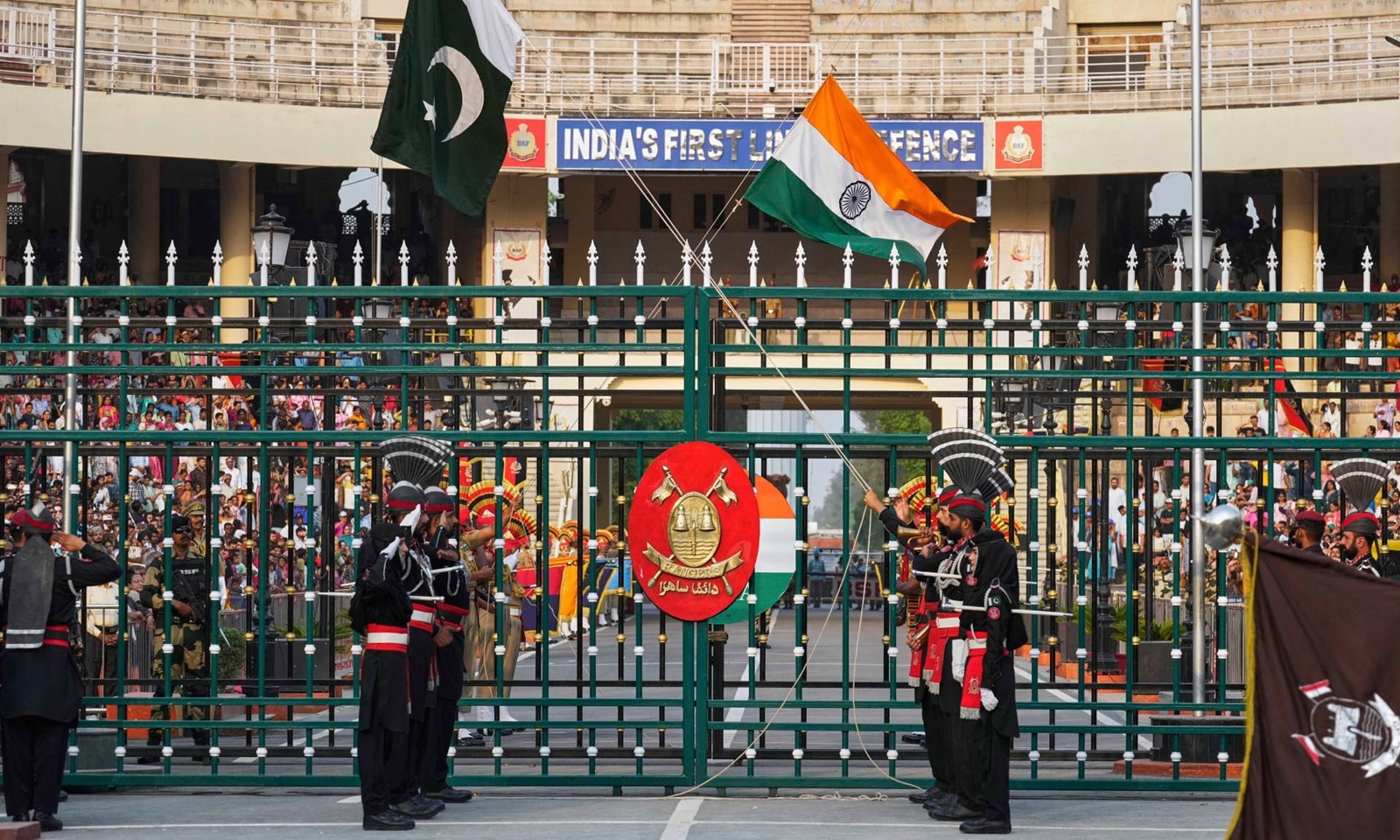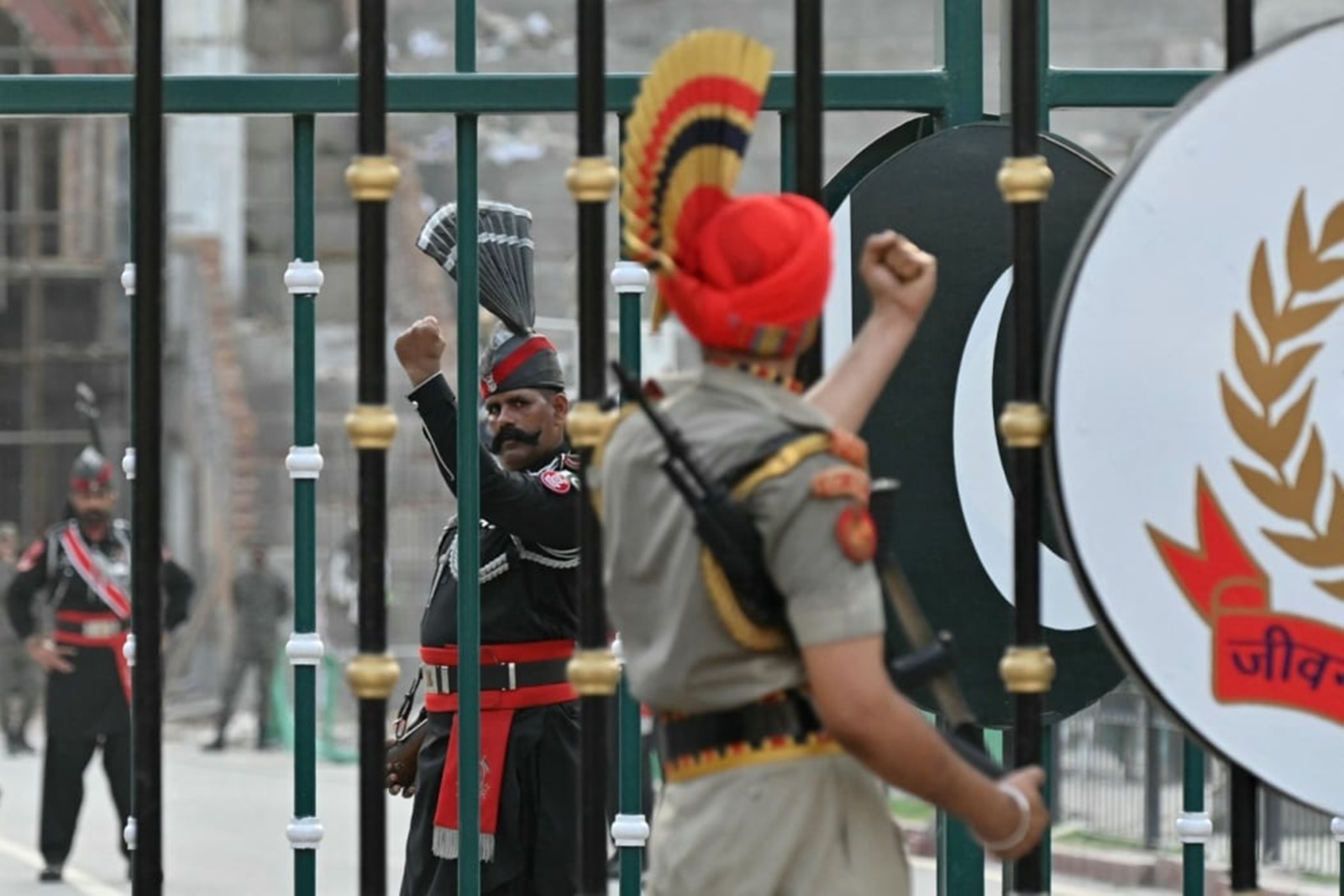For years, India and Pakistan have engaged in elaborate flag-lowering ceremonies at the Wagah border crossing. The rival South Asian nations use the daily ritual as an opportunity for their border guards to compete, not just in drills and the colorfulness of their uniforms, but also in physical appearance.
Each day at sunset, as crowds cheer and chant slogans from bleachers on opposite sides of the border fence, guards from both sides display fervent patriotism with synchronized stomps and high kicks.
This has fueled an intense rivalry, especially since May, when a 4-day clash between Indian and Pakistani troops pushed the nuclear-armed powers to the brink of all-out war.
 |
Pakistani Rangers, in black, and Indian Border Security Force personnel, in khaki, during the flag-lowering ceremony at the Wagah border crossing. Photo: AP |
Pakistani Rangers, in black, and Indian Border Security Force personnel, in khaki, during the flag-lowering ceremony at the Wagah border crossing. Photo: AP
"We can't be seen as any less than the Pakistani side, whether it is height or appearance," said Himanshu Yadav, deputy commander of the Indian Border Security Force (BSF) at Wagah. "That's why the best are sent here."
Tensions remain high even after a cease-fire agreement ended the fighting. According to Lieutenant Colonel Azam Shah, commander of the Pakistani Rangers at Wagah, in the days following the truce, some Indian guards broke with long-standing protocol by repeatedly raising their fists toward the Pakistani side and shouting insults.
"They would insult our soldiers, calling them 'cowards' or whatever," Shah said, adding that the atmosphere has calmed somewhat after commanders from both sides held meetings to address the behavior.
However, Vishal Singh, an Indian BSF company commander, denied the accusations, insisting any actions by his men were simply competitive, not political.
"For example, when you are kicking your legs, there is a sense of competition as to who kicks higher," he said.
The flag-lowering ceremony at the Wagah border crossing between India and Pakistan in 2023. Video: VOA
For decades, both countries have invested heavily in the ceremony, building grand venues and attracting larger crowds.
The title of tallest flagpole at the border has repeatedly changed hands. In 2017, India installed a nearly 110-meter flagpole at the crossing. Just months later, Pakistan surpassed it with a nearly 122-meter pole. Six years later, India regained the lead with a 127-meter flagpole.
"This is a golden day in my life," India's transport minister said at the inauguration of the new flagpole.
Not to be outdone, Pakistan is constructing a new viewing stand modeled after a historic gateway built during the Mughal empire. The 11 million USD project, slated for completion next month, will triple capacity to 25,000 seats and feature a modern museum and VIP lounges.
Pakistan also plans to increase the height of its flagpole to 137 meters, surpassing India once again.
Wagah has been the main road crossing between India's Amritsar district and the Lahore area of Pakistan since 1947, after the British ended colonial rule and partitioned British India into India and Pakistan.
The origins of the daily flag-lowering ceremony date back to that time. Initially, armed forces on both sides of the now-divided Punjab province performed simple flag-lowering rituals at the village of Wagah. In the 1970s, the two countries began coordinating more elaborate ceremonies in a spirit of friendship following the 1971 Indo-Pakistani War. But things quickly became competitive.
Over the years, there have been attempts to de-escalate tensions. In 2010, the two countries agreed that their border guards would shake hands longer and smile instead of scowling during the ceremony. However, this protocol has sometimes been ignored during periods of heightened bilateral tension.
On a recent afternoon, as workers hurried to complete the new stand on the Pakistani side, hundreds of people in the old bleachers chanted "Long live Pakistan!" and "God is great!". Their cheers were drowned out by thousands of spectators on the Indian side chanting "Long live India!" and singing patriotic Bollywood songs from their bleachers across the border.
Indian and Pakistani border guards during the flag-lowering ceremony. Video: YouTube/adarshbalak108
Divya Gupta, a 51-year-old homemaker from New Delhi visiting childhood friends, insisted on stopping at the border to pay her respects to the Indian guards.
"Especially after all that India and Pakistan have been through, our patriotism is even stronger," Gupta said, wiping away tears.
As the ceremony began, two female border guards from each side marched toward the border fence, followed by male guards. At the border gate, which has remained closed since the recent clash, Indian guards flexed their biceps toward their Pakistani counterparts, who returned the gesture.
Then, a larger contingent of soldiers raised their fists, glared, and twirled their mustaches defiantly. Occasionally, one would pause to adjust his turban, complete with a peacock-feather plume.
Both sides have basic criteria for the guards who participate in the ceremony: they must be tall, have a strong physique, and, ideally, possess a thick mustache.
 |
Indian and Pakistani soldiers raise their fists towards each other during the flag-lowering ceremony. Photo: AFP |
Indian and Pakistani soldiers raise their fists towards each other during the flag-lowering ceremony. Photo: AFP
Shah, the Pakistani Rangers commander at Wagah, who is 1.82 meters tall, said that is the minimum height for a soldier in the parade. Male soldiers also receive a special allowance to buy oil and ointment to maintain their mustaches. A unit barber provides free trims.
"My soldiers have very thick mustaches," Shah said. "It makes them look powerful. It adds to the masculinity of any man."
India also encourages facial hair for its border guards. While not all male soldiers at the crossing are required to be taller than 1.82 meters, few are below that height.
"The bigger, the better," Singh said. "It looks good."
Vu Hoang (Adapted from WSJ, AFP, Reuters)












